There are a number of tendons (fibrous tissue that connect muscle to bone) in the foot which help to control movement while you are walking or running. Two ankle tendons commonly injured are the peroneus longus and the peroneus brevis, and together, these are known as the peroneal tendons.
The "Peroneal Tendon" is actually a name given to two tendons: the Peroneus Longus and the Peroneus Brevis. Together, they are harness all the strength pertaining to the outside of the ankle (this is known as "lateral ankle strength").
These 2 long tendons have acquired this name because they harness most, if not all, the strength pertaining to the outside of the leg/ankle. The peroneal tendons are important tendons because they prevent the foot from rolling and causing a lateral (inversion) ankle sprain. The superior peroneal retinaculum and inferior peroneal retinaculum ligaments run over top of the 2 peroneus tendons holding them close to the calcaneus (heel bone). If these 2 tendons were cut, you would have no ability to prevent your foot from turning inward when you walk, effectively causing constant ankle rolling. If these tendons are overstrained and too long, you will find the same thing happening - you will be frequently having ankle inversion sprains.
Peroneal tendons are long, attaching to outer leg muscles then running behind and underneath the bone (fibula) on the outside of the ankle. For some people, injury can cause the natural holding structure to fail and allow these tendons to slip over the bone. In such cases, this is usually called a peroneal tendon dislocation. When they slip into this position the peroneal tendons become slightly weaker than the muscles and tendons on the inside of the ankle. Due to this (you probably guessed it), you are more likely to roll your ankle inward and sprain it on a frequent basis.

Peroneal Tendon Dislocation (subluxation) or Tearing may occur in one or both of these tendons. This leads to pain, swelling, sensitivity and a sense of instability behind the outside of the ankle. They can also pop out of the supporting ligaments that hold them in place which is termed a dislocation. Once this occurs, continuous or recurrent dislocation and tearing may occur without immediate attention and repair. Stitching and at the worst, tendon replacement may be required for patients suffering from torn or dislocated peroneal tendon(s).
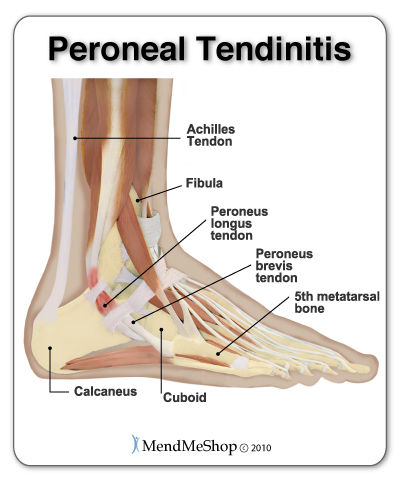
Peroneal tendonitis (also spelled tendinitis) is the inflammation and irritation of one or both of the peroneal tendons. Like all forms of tendonitis, peroneal tendonitis is a condition that may flare up and subside over a period of time.
Peroneal tendinitis is usually caused by repetitive use of the tendons, but can also be caused by trauma such as a rolled or sprained ankle. Little tears in the peroneus longus tendon and the peroneus brevis tendon irritate the tendon fibers resulting in pain and inflammation.
Peroneal tenosynovitis is swelling and inflammation of the peroneal tendons' sheaths (or coverings) which prevents the tendons from gliding smoothly within the sheaths causing pain. It can be experienced at the same time of peroneal tendonitis, and has similar symptoms. It often results in trouble moving the ankle and will feel sore to the touch. In rare cases, tenosynovitis can be caused by infection, so it is always recommended to check with your doctor to rule this out as a cause.
Tearing of the peroneus longus tendon and/or the peroneus brevis tendon can occur. This leads to pain, swelling, sensitivity and a sense of instability in the ankle. The tendon(s) can also pop out of the supporting ligaments that hold them in place (superior peroneal retinaculum and inferior peroneal retinaculum ligaments) which is known as dislocation.
Peroneal tendon injuries may happen suddenly through an acute incident / accident / trauma or develop over a period of time from over-use or re-injury (a chronic condition).
If you have peroneal tendonitis you may feel:
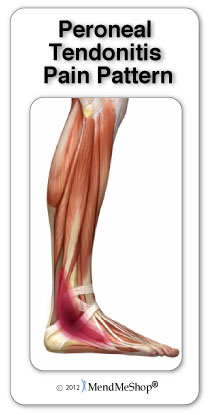
It is important to recognize pain in these areas compared to pain over the fibula (your ankle bone) which might indicate a different problem like a stress reaction of the bone or fracture. Pain on the fibula occurs directly over the bone which is easily felt with your fingers. Peroneal tendon injuries are sometimes misdiagnosed and may worsen without proper treatment, prompt opinion by a foot and ankle doctor is advised.
Peroneal tendonitis is the degeneration of the tendon tissue in the ankle. What causes our tendon to start to fall apart?

The diagnosis of peroneal tendonitis is usually made by examination of the ankle. A physical check by your doctor will help to determine where the tendons are inflamed, ruptured, or degenerated. The doctor will move your ankle into different positions during a physical examination. The peroneal tendons are checked by holding your foot up and out against the doctor's downward pressure. Stretching the foot up and in can also be used to test whether the tendons hurt. The doctor will also be looking for instability of your ankle joint, swelling, warmth and weakness on the outer side of your ankle.
X-rays may be ordered to make sure there is no fracture or other problem with your fibula or the other bones in your ankle. Your doctor may order a magnetic resonance imaging (MRI) scan of your ankle. These images can show if there is abnormal swelling or scar tissue in the tendons. MRI scans can also show lengthwise tears in the tendons.
If you have a lot of pain you may need to have a walking boot or cast for 2 to 4 weeks. If there is no pain or tenderness with walking a stirrup ankle brace, arch support, or lateral heel wedge can help to take tension off of your injured tendons.
In most cases, your Doctor will start with non-surgical treatments options. Some of the options your doctor may recommend include drugs or medications like NSAIDs (non-steroidal anti-inflammatory drugs) to manage pain and inflammation. Steroid injections are advised with caution for any type of tendon condition as there is increased risk of tendon rupture.
(reference: American Academy of Orthopaedic Surgeons)
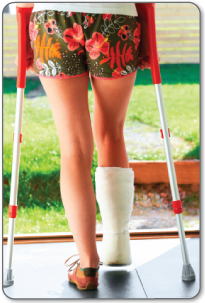
For acute (new or recent) Achilles tendon tears that have the ability to heal on their own - your doctor may even cast your foot in a toe pointed position (in something called a "hanging enquinus cast") or in a removable brace/splint. A removable splint can be very helpful to prepare you for PT sessions and mobility exercises.
Prolonged use of a cast, removable splint, or long-term rest (restricted movement) without proper exercise or stretching can make your Achilles tendon injury worse. If your Achilles tendon remains completely immobilized and at constant rest, the ends of the Achilles tendon (where it attaches to bone or other muscles) will begin to fill in with scar tissue as part of the healing process. You may also have on-going symptoms of pain, swelling and inflammation, and even poor blood flow circulation.
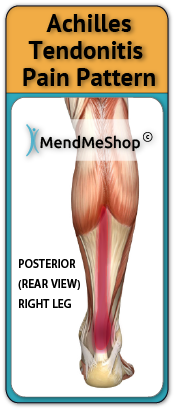
Lack of proper blood flow and growth of scar tissue will decrease the natural length of the tendon (atrophy) and tighten tissue, reducing the flexibility between your ankle and foot. Your ability to push off with your foot in certain activities such as running, jumping, or going up and down stairs all become compromised. You are also at an increased risk of re-rupture of the tendon, especially if the initial injury was large and required surgery in the first place. In summary, resting/casting/splinting of a compromised/injured tendon is good if done properly, but it is important to not rest it for too long as this will cause more issues related to atrophy.
The tendon tries to protect itself from irritation by trying to repair damaged tissue. During the healing process your body will automatically fill in tears in your tendons with dense, brittle tissue called "scar tissue". The human body will use scar tissue as a temporary healing solution and will try to build the scar tissue as fast as possible to heal tears in your peroneal tendons. Scar tissue can form fast to strengthen the damaged tendon, but working fast doesn't mean that the job's done right. When scar tissue forms it doesn't come together as neatly as regular (healthy) tendon tissue would. Scar tissue fibers will lay down over top of your tear in a cluttered, messy and jumbled up way.

This is how scar tissue works. The scar tissue that forms in and around your strained ankle tendons will be unorganized and won't line up properly with the healthy tissue surrounding the tear. This scar tissue will also attach to everything in and around your ankle including the surrounding healthy tissue as well. This can result in a long-term fusing together of your tendon with everything around it; this will definitely freeze up your ankle, severely reducing your mobility.
Scar tissue is a weak form of collagen - hard, inflexible, and tough to get rid of once it begins to take hold. The more scar tissue that develops, the more you lose range of motion. With excess scar tissue build up, the injured soft tissue and the ankle in general will remain weak and prone to re-straining and re-tearing.
While you can go a number of days and even a few weeks without any major setbacks during the injury.. inevitably, a certain movement or motion will happen that causes your injured soft tissue to strain and even tear once again. This is attributed to the scar tissue build up and will result in the buildup of yet more scar tissue and a further reduced range of motion (ROM).
The more scar tissue that develops, the greater the risk of winding up permanently injured with chronic pain or arthritis. Scar tissue means that your joint will not perform as well as it once did and it makes it much more prone to injury later on. The longer the injury remains, the risk of atrophy increases and the risk of more scar tissue increases. This is why it is critical to treat your tendon injury now rather than later.
If you have a lot of pain you may need to have a walking boot or cast for 2 to 4 weeks. If there is no pain or tenderness with walking a stirrup ankle brace, arch support, or lateral heel wedge can help to take tension off of your injured tendons.
In most cases, your Doctor will start with non-surgical treatments options. Some of the options your doctor may recommend include drugs or medications like NSAIDs (non-steroidal anti-inflammatory drugs) to manage pain and inflammation. Steroid injections are advised with caution for any type of tendon condition as there is increased risk of tendon rupture.
(reference: American Academy of Orthopaedic Surgeons)
The first step for conservative treatment of your foot tendonitis is to reduce the swelling to "open up" the area for more blood flow. Anyone in the health-care business knows that your blood supplies the oxygen and much needed nutrients required to heal foot tendonitis injuries. This is why for years, doctors, trainers, and other medical professionals have recommended RICE (Rest, Ice, Compression, Elevation) to treat the pain and swelling of fresh injuries, chronic pain, and after any re-injury.
This is important because once blood vessels are blocked or damaged, they can no longer carry oxygenated blood to your damaged tendon and tissues begin to break-down. Without cold compression, tissues break down further because they can't get the oxygen they need to survive. By limiting the amount of damage done to your tendons, you also limit the amount of healing that needs to occur. This is a very important step to heal acute or chronic tendon injuries faster and with less pain!
Once the swelling is gone, moving the tendon and applying a local circulatory stimulation device like the TShellz Wrap® is really what is needed for completing the recovery cycle. This is critical because tendons are known to receive very little natural blood flow and blood flow is really how your body is able to heal itself. When the tendon tissue is damaged, the already-reduced blood flow is decreased down to a trickle which is why movement is encouraged - it helps get blood flow to where it is needed.
Blood flow (healthy circulation) is an important part of natural tissue healing. Injured tendons take the nutrients available in local blood flow (like oxygen and healing agents) to get rid of any damaged tissue and start growing healthy tissue.
In some cases of acute tendonitis, the micro-tearing is located in an area known as the watershed zone.
The watershed zone is basically a part of the tendon that has the weakest amount of blood supply (even when it's completely healthy with no tears). This area usually gets blood supply from peripheral veins. This reduced blood supply makes the watershed zone an area of your tendon that's prone to injury and a poor healing response.
Many tendons in the body are known to have watershed zones that are prone to tendon tears. Some of the tendons that have a watershed zone include the Achilles tendon, the posterior tibial tendon in the foot / ankle, the rotator cuff (supraspinatus) tendon in your shoulder, the bicep and tricep tendons in your arm and the flexor tendons in your hand.
TShellz Wraps® contain a unique Carbon Fiber Energy Pad which is flexible and will shape to conform to your body. This Energy Pad emits a uniform wave of perfectly safe energy over its entire surface. This energy is absorbed by soft tissue in the treatment area, opening blood vessels, resulting in an increase in blood flow. Increased blood circulation is what your body needs to accelerate the healing of soft tissue and this is why we recommend the TShellz Wrap®.
The TShellz Wrap® is an FDA Registered Medical Device and is suitable for use in therapeutic clinics and FROM HOME. It is completely safe for people and patients to use for themselves.
The technology found in a TShellz Wrap® has been used for decades in the worlds of professional and amateur sports - a contributing factor as to why athletes seem to recover from injuries so quickly.
Have you ever wondered by an athlete can return to activity after 3 or 4 weeks following a soft tissue injury - while your average person takes much longer to return back to normal? The secret isn't really that much of a secret - it involves consistent treatments (meaning multiple times a day) using a treatment like the TShellz Wrap® to stimulate blood flow to the injured tissues. Most athletes have the luxury of using in-house facilities many times per day.
How many us can afford the time and money to visit a clinic multiple times a day? Very few indeed. This is how you can gain some of the advantages that athletes enjoy in their injury recovery - by using a device like the TShellz Wrap® two or three times a day on a consistent basis.
We believe the TShellz Wrap® to be one of the most effective home treatments to increase localized blood flow to soft tissue in and around the treatment area.
We can promise that you will receive a product that is designed to be safe and does what it is supposed to do... reduce pain (as stated in "Therapeutic Heat and Cold", 4th edition. - Ed. Justus F. Lehmann, M.D., Williams, and Wilkin) temporarily increase length & flexibility of soft tissue (as stated in "Therapeutic Heat and Cold", 4th edition. - Ed. Justus F. Lehmann, M.D., Williams, and Wilkin) and aid your body in recovering from tendon, muscle and other soft tissue injuries via enhanced blood flow.
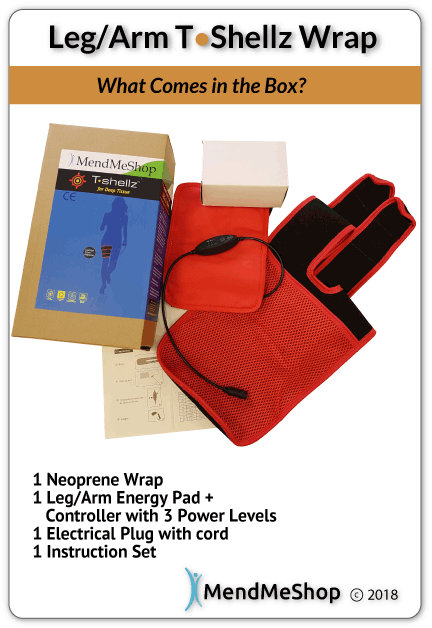
The unit plugs into a standard wall outlet to get its power. The nice thing about the power supply is that the same unit can be used in North America and overseas as well. It has the capability to operate between 110v and 230v.
The TShellz Wrap® has a special signal controller that can be set for 3 different power levels of application (3=High, 2=Medium, 1=Low). The cord is long enough that you can sit or lie comfortably and watch TV, read or surf the net while you're using it.
Treatments are max 30 minutes in duration and the device can be worn over clothing. This allows you to use the device at work, at home, or really anywhere you have access to an electrical outlet.
Click HERE to Go To Our Online Store If you have questions, call our office at 1-866-237-9608 (toll free continental US).
We believe the TShellz Wrap® to be one of the most effective treatments to stimulate blood flow to dense, injured tissues such as muscles, tendons, ligaments, and other similar tissues.
We can promise that you will receive a product that is designed to be safe and does what it is supposed to do...quickly relieve pain and aid in the recovery from tendon, muscle and other soft tissue injuries.
The unit plugs into a standard wall outlet to get its power. The nice thing about the power supply is that the same unit can be used in North America and overseas as well. It has the capability to operate between 110v and 230v. It has a special signal controller that can be set for 3 different power levels of application (3=High, 2=Medium, 1=Low). The cord is long so you can sit or lie comfortably and watch TV, read or surf the net while you're using it.
We recommend 5 to 10 minute treatments to start; the safety shutoff controller is set to max 30 minutes in duration. The device can be worn over clothing and allows you to use the device at work, at home, or really anywhere you have access to an electrical outlet.
The most common question we receive from individuals prior to purchasing is - how many times a day should I be using my wrap and when should I be using them? While treatment plans will differ for each individual and their specific injury, there are general guidelines that should be adhered to.
The TShellz Wrap® would then be used:
The final step in foot tendonitis recovery is stretching - this is a critical step for complete recovery from your injury!
PTs almost always prescribe gentle stretching for to deal with foot tendonitis, and they will typically prescribe a set of stretches for you to do at home. In a clinic, your PT will help you to perform these stretches and exercises if your foot hurts too much to do it on your own.
You'll find in most rehabilitation programs, stretching combined with conservative treatments at home will help to:
It's important to rest a partially torn or strained tendon because our natural healing process takes time to heal completely. If you don't rest your torn tendon, your acute tendonitis can quickly turn into a chronic tendonitis injury. To repair our damaged tendon tissue quickly, our bodies will use scar tissue to fill in the tears in the tendon. If you need to rest for an extended period of time and avoid certain activities that make your pain worse, you'll be more likely to develop massive amounts of this scar tissue as a temporary healing measure.
Scar tissue may plague you for weeks, months and maybe even years, depending on your level of activity and the amount of conservative treatments you have done during your rehabilitation. Scar tissue is a major problem, especially when it comes to re-injury of your tendon.
When dealing with scar tissue it's always important to:

Conservative treatment tools just like these have been used successfully by thousands of soft tissue injury sufferers - just like you.
We believe the use of TShellz® Circulatory Boost Wraps for boosting blood flow to soft tissue in the area of application is one of the most under-utilized home treatment options available on the market today. We have client after client that have tried many options out there and have been amazed at how effective and fast the TShellz Wrap treatment can relieve pain and increase blood flow in the treatment area.
With regular use of the TShellz® Circulatory Boost Wrap:
*Know that every personal soft tissue injury is unique and the TShellz Wrap may not work for everyone. This is why we offer a 60-day money back return on all our TShellz Wrap devices.
We all know that if the injury was healed, the pain would go away but what about the opposite situation? If the pain is gone, does that mean the injury is better? Unfortunately, this is not always true.
Too many people only focus on suppressing pain symptoms while providing less attention to the true healing aspects of the body. Experiencing less pain, while obviously a good short-term goal, does not equate to underlying healing. Scar tissue can remain for months after one gets to a point of being relatively pain-free. However, as long the weak and brittle scar tissue remains, you are susceptible to re-injury or re-aggravation. Certain motions or movements can cause the weaker tissue to easily tear - resulting in some reversal of the recovery up until that point.
This is why we recommend for people to continue with their doctor or therapist recommended exercises and to continue with mild treatments of the TShellz Wrap® for a period of time - to better ensure complete recovery.
Ongoing treatments to enhance circulation are intended to soothe, relax and promote healing of damaged soft tissue in the application area. T•Shellz treatment also results in the ability of soft tissue to extend further due to the effect of heat on soft tissue. The more extensible your tissues are, the less likely they are to strain or sprain.
People tell us all the time, "I was told that if I stay off my feet for a few weeks, my pain will disappear for good."
The truth is, tendonitis pain is usually a culmination of numerous factors, such as repetitive stress, poor posture, acute injuries, and overcompensation issues resulting from other muscle and soft tissue ailments.
It may take weeks or months for these pain triggers to surface. When they , however, merely resting will solve the underlying issues. You need to utilize actions and options that actually treat the source of the pain and help reverse the damage that has been done.
Resting has a role to play, but it is only one small factor in a recovery plan.
Preventive measures for all types of foot tendinitis include, proper warm up and stretching exercises, wearing the right shoe for the activity, choosing shoes with good arch and heel support and varying your exercise route and routine. (This will help keep one set of muscles from being overstressed).
Gentle stretching is important to help align scar tissue along the normal lines of stress and strength in the healing tendon is enhanced. Scar tissue is fibrous and brittle, without the correct alignment you're left with a weak ankle. You'll have pain and tightness in your ankle for even the smallest daily activities, an this will greatly increase your chance of re-injury.
Product Advisors are available 9:00 am to 5:00 pm Eastern Standard Time Monday to Friday.
I want to learn more about Post-Surgery Recovery
I want to learn more about TShellz Wrap® Circulatory Boost
I want to learn more about Ice & Heat: Which Is Better For Treatment?
I want to learn more about Tendonitis Treatments
I want to learn more about Tendonitis Surgery
During your recovery, you will probably have to modify and/or eliminate any activities that cause pain or discomfort at the location of your soft tissue injury until the pain and inflammation settle. The more diligent you are with your treatment and rehabilitation, the faster you will see successful results!
Please be aware that this information is neither intended nor implied to be a substitute for professional medical advice. CALL YOUR HEALTHCARE PROVIDER IMMEDIATELY IF YOU THINK YOU MAY HAVE A MEDICAL EMERGENCY. Always seek the advice of your physician or other qualified health provider before using any of our outstanding products to make sure they are right for you and your condition or if you have any questions regarding a medical condition. Always see your doctor for a proper diagnosis as there are often many injuries and conditions (some very serious) that could be the cause of your pain.
© 2025 In.Genu Design Group, Inc. Contact Us